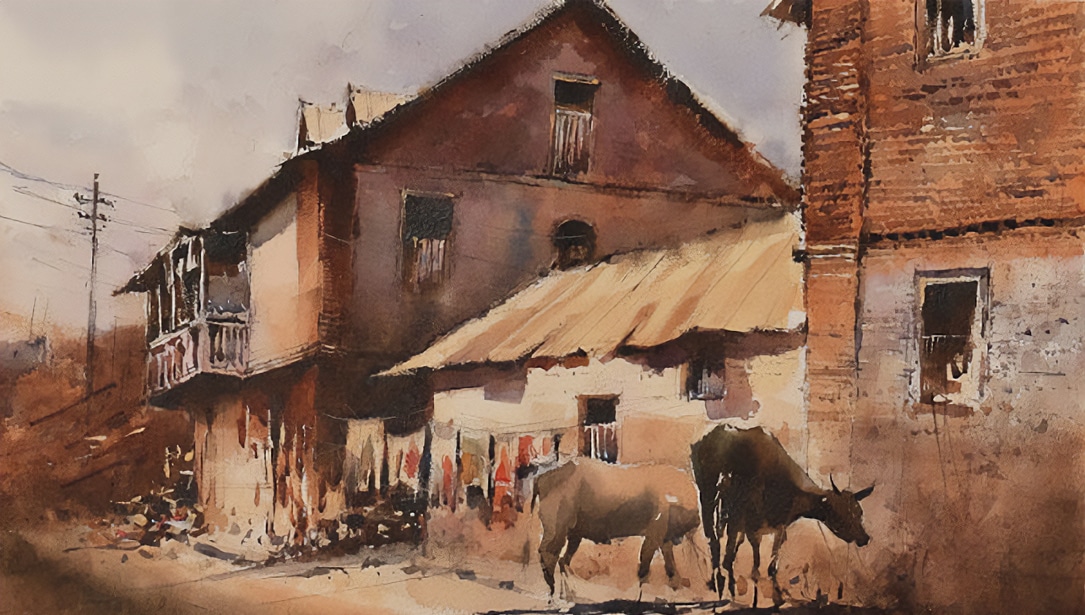Share:
In this step by step watercolor demonstration, I will show how I plan and work. My subject is an old door with some rusty metal and a torn poster, I will be painting them using DANIEL SMITH watercolors.
Old things, closed doors, weathered wood, rusty material have some mystery and convey melancholy. When I see a closed door… I sometimes question myself what would be beyond? What is inside? There is certainly some mystery involved. And then… especially when something is old, you start to think about the stories of the place. Who lived or worked there? What kind of joyful or other stories were recorded in that place? Such things that refer to an earlier age are so touching. On the other hand, they are normally far from beautiful. This is my goal: to render them in a way to present all the feelings they evoked to me. To make the subject stand out and become striking! This is a matter of planning, composing and using the right contrasts and value relations….

‘Old Door” by George Politis
In my first attempt, after I did some sketches, I painted “Old door”. In that painting I painted mostly what was in the real door. I was following more or less the colors I saw… The result was very good and I liked it a lot, but perhaps it was too bright for my taste, not too much mystery… I used several colors like Kyanite Genuine, Sleeping Beauty Turquoise Genuine, Moonglow, Burnt Sienna, and Quinacridone Gold (a real, “must use” in my paintings).

Pencil sketch for “Old Door with Torn Poster”
I did several sketches trying to explore the composition and the potential of the subject and add to the feeling of an old, more atmospheric, inviting and mysterious setting. In these sketches the decisions were to suggest more texture, to create more contrasts and to introduce a paper poster that might have been glued on the wood in the past. Several ideas about where to put the “paper” poster, how it would be torn and weathered, and how it would help the composition…
Above is the sketch that I liked most…

Step 1, “Old Door with a Torn Poster”
Step 1. I almost always start with a warm color (usually yellows and light reds) underpainting. In this painting I start creating texture from the first moment. Quinacridone Gold, Raw Sienna and Burnt Sienna, with just a touch of Neutral Tint here and there. These colors give a warm effect in the finished painting. Texture will be built in several layers.

Step 2, Old Door with a Torn Poster
Step 2.
More texture and colors.
The metal parts are painted and spattered. I painted using Burnt Sienna, Quinacridone Gold in layers. I spattered with white acrylic (using a toothbrush) and then more layering with Venetian Red, Burnt Sienna and Hematite Genuine.
Wood texture is also is painted using Burnt Sienna, Hematite Genuine, Moonglow… and this is done with little water, like in dry brush.
I also start working on the torn paper some of the colors in other parts of the painting. I also introduce Sleeping Beauty Turquoise Genuine.

Step 3, Old Door with a Torn Poster
Step 3.
Using mostly the same colors I work with the values of the painting, producing darker shapes and more contrast.
The metal parts are painted and spattered. I painted using Burnt Sienna.
More texture painted.
I work all around the painting, trying to create a balanced effect. I try to make certain areas “glow” in light by placing darker colors around them. Contrast is the key!

Step 4, Old Door with a Torn Poster
Step 4. Trying to achieve a more dramatic effect. More Sleeping Beauty Turquoise Genuine in the paper, along with random lines and dragging color from the wood area to unify everything. More darks are painted using drybrush strokes. This gives the feeling of texture on the wood and metal and light comes through to produce more interest.

Step 5, “Old Door with a Torn Poster”, 15 x 22 inches, by George Ploitis
Step 5.
The finished painting. After several layers, many evaluations before continuing with each next step… I always paint in many layers, with patience… I don’t like to push things. I prefer to stop, step back, evaluate, paint again … and so on.
I consider the painting finished when I am satisfied with the overall effect. —George Politis







